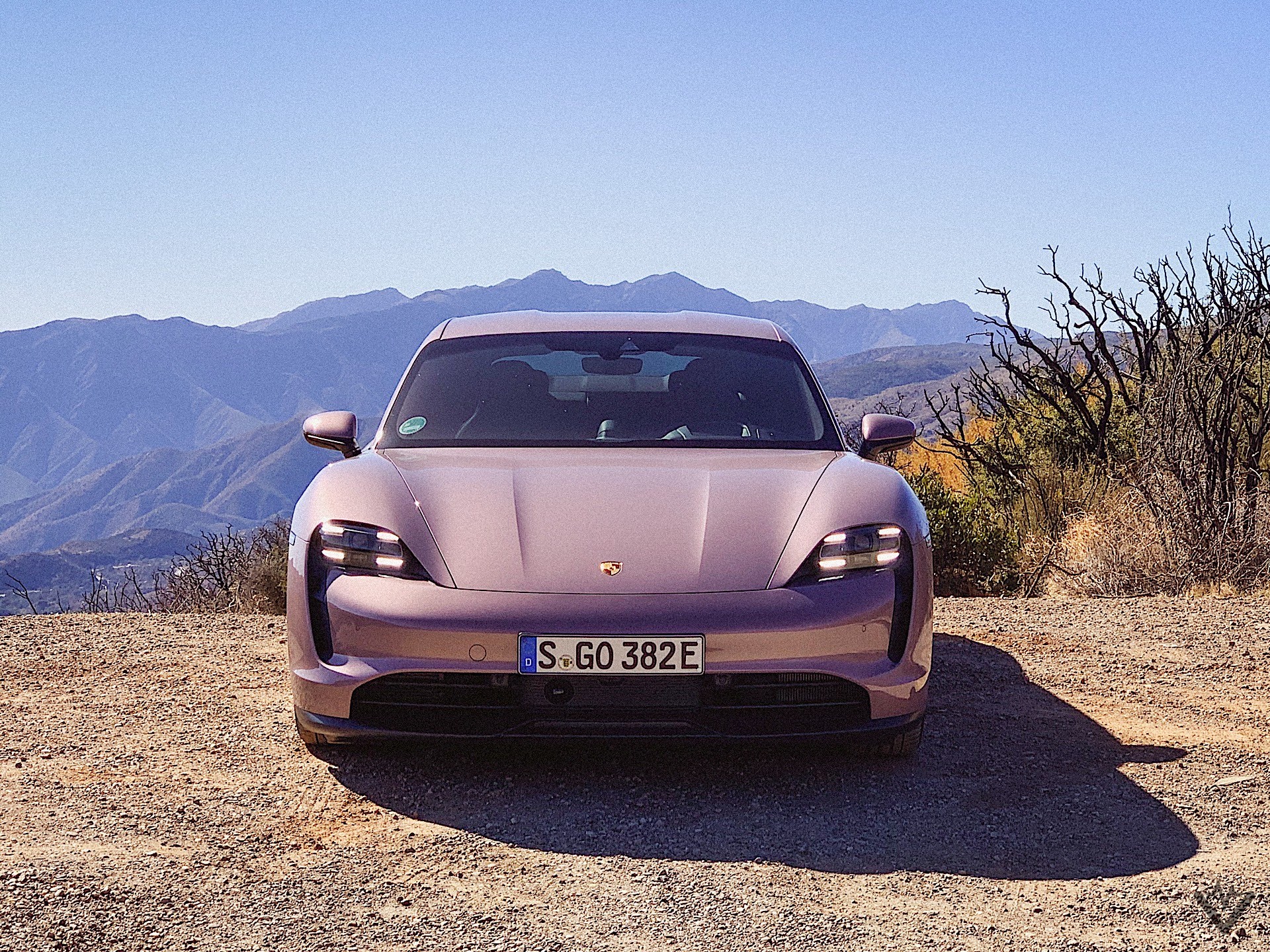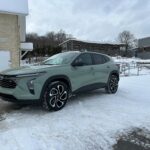Porsche insists they only build sports cars, even when discussing their popular SUVs and the Panamera sedan. While that might be a stretch for some models, it’s undeniably true for the Taycan. Since the Boxster’s debut in 1997, Porsche has delivered another genuine sports car to its lineup, and this time, it’s electric. The Taycan isn’t just an EV; it’s a Porsche sports car through and through.
For those unfamiliar, the Porsche Taycan is a compact, all-electric sedan that screams Porsche from every angle. Its wide stance and iconic fender lines are unmistakably Porsche, setting it apart on the road. But the Taycan’s Porsche DNA is most evident once you’re behind the wheel. It delivers the engaging driving experience that electric vehicle enthusiasts have been craving. It’s truly exceptional.
My first encounter with the Taycan Turbo S back in 2019 was nothing short of love at first drive. It was an intense experience, fueled by 750 horsepower and all-wheel drive. For a Porsche costing nearly a quarter of a million dollars, you’d expect a thrilling experience, and the Turbo S delivered in spades. The sheer power and speed were intoxicating.
Image of a Frozen Berry Metallic Porsche Taycan parked on a scenic road, showcasing its sporty design and vibrant color.
After that initial encounter, I wondered if such exhilarating performance was reserved only for the ultra-rich. However, the subsequent launch of the Taycan 4S, with equally glowing reviews, offered hope for a more accessible enthusiast EV from Porsche. Despite a global pandemic and a premium price tag, Porsche sold 20,000 Taycans in 2020, proving its market appeal. The Taycan was clearly a hit.
Then came the rear-wheel-drive Taycan, and things got even more interesting.
Porsche opted for a single rear motor in the standard Taycan, a nod to traditional sports car configurations. This rear-wheel-drive setup reduces weight, enhancing both performance and efficiency. By removing the front motor and drive components, the front tires are solely dedicated to steering. With the heavy battery pack positioned low and centrally, the rear-wheel-drive Taycan promised even sharper handling. While “only” producing 469 horsepower, the base Taycan is far from slow.
Image highlighting the rear three-quarter view of a white Porsche Taycan, emphasizing its wide rear fenders and sporty silhouette.
The base Taycan shaves off 400 to 500 pounds compared to the Turbo and Turbo S models. While still not a lightweight car, it feels more agile. In a world where sports cars are increasingly bulky, the Taycan cleverly masks its weight. The test model I drove featured active air suspension and rear-wheel steering, further enhancing its nimble feel, defying its 4742-pound curb weight.
CHECK OUT: 2021 Porsche Taycan 4S review
Beyond the nuanced driving dynamics, the slightly slower 0-60 mph time (just over 5 seconds), and the absence of front-wheel drive, the standard Taycan evokes a remarkably similar feeling to the Turbo S I experienced earlier. Porsche’s renowned build quality is evident throughout, with precise panel gaps, a beautifully designed interior, vibrant displays, and premium materials that surpass its competitors.
Historically, Porsche sports cars have been accessible to the middle class and above, while truly groundbreaking models were often exclusive to the wealthy. The base Taycan changes this. While an $80,000 starting price is still significant, it’s within reach for a broader range of drivers compared to the higher-end Taycan models. It’s not just the most attainable Taycan; it might be the most compelling. While I might not be rushing to buy one today, a certified pre-owned Taycan in a couple of years? That’s a definite possibility.
Interior shot of the Porsche Taycan showcasing the Blackberry and Frozen Berry two-tone leather interior, highlighting the luxurious materials and sporty design.
Although the base rear-wheel-drive Taycan is the value proposition in the lineup, the test car was equipped with options pushing its price higher. While Porsche didn’t provide an exact MSRP for this European-spec model, the options suggested a price around $110,000. Many options are desirable but not essential. This particular car featured the extended range battery, adaptive air suspension, rear steering, Sport Chrono package, noise-insulated glass, adaptive cruise control, and a striking Frozen Berry over Blackberry color scheme.
If I were configuring my own Taycan, I’d skip some of the pricier extras, like the extended range battery. However, the 150 kW onboard charger is a must for utilizing fast charging networks. A splash of color like Frozen Berry or Gentian Blue adds personality without breaking the bank. Adaptive cruise control, while arguably essential on an $80,000 car, is unfortunately an optional extra. Heated seats and steering wheel, combined with bronze interior accents, create a comfortable and stylish daily driver for around $86,520. Aftermarket lightweight wheels could further enhance range and aesthetics.
Porsche generously allowed me a full day with the Taycan in Southern California, and I made the most of it, covering over 400 miles. I explored my favorite driving roads, recharged during a coastal lunch break, and returned late in the day. Even with spirited driving, I managed 223 miles on the initial charge with 45 miles of range remaining. With the extended range battery and a more conservative driving style, exceeding 300 miles on a single charge should be easily achievable.
Image of the Porsche Taycan charging at an Electrify America charging station, emphasizing its compatibility with fast-charging infrastructure.
However, the standard 50 kW onboard charger felt slow after experiencing faster charging speeds at Electrify America and Tesla Supercharger stations. While the Taycan is compatible with fast charging, the standard charger limits its peak charging rate to 50 kW.
For daily driving, the standard 79.2 kWh battery with a 215-mile range is acceptable, especially with fast charging available for longer trips. Saving weight by forgoing the larger battery can even enhance the driving experience. While the smaller battery reduces peak horsepower by 67 hp, 402 hp is still ample for a daily driver.
It’s impossible to discuss the Taycan without mentioning the Tesla Model S. Tesla’s recent Model S refresh clearly aims to counter competition from the Taycan and the Lucid Air. Tesla’s price increase for the Model S to match the Taycan’s starting price of $79,990 is telling. While the Model S offers dual-motor all-wheel drive, quicker acceleration, and longer range at that price point, the Porsche Taycan excels in driving enjoyment, build quality, and overall value in its segment. Plus, the Taycan still qualifies for a $7,500 federal tax credit.
Is the Taycan a Tesla killer? Not exactly. But if you prioritize a true sports car experience from a legacy sports car manufacturer, and you want to go electric, the Porsche Taycan is currently in a league of its own. For now.
Updated (11:07am EST, 2/8/2021): Clarified fast charging information.

